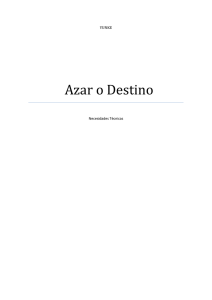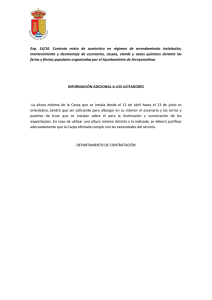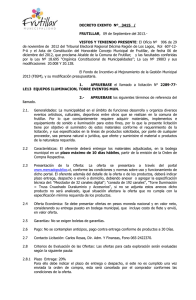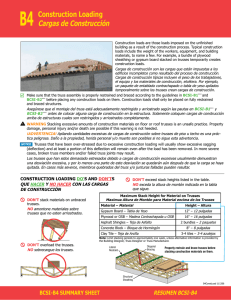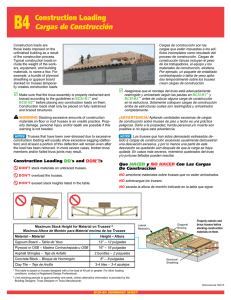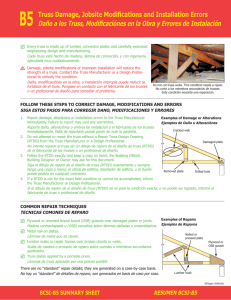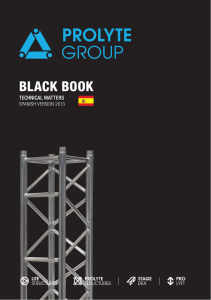Multi-Ply Girders Travesaños Varias-Capas
Anuncio
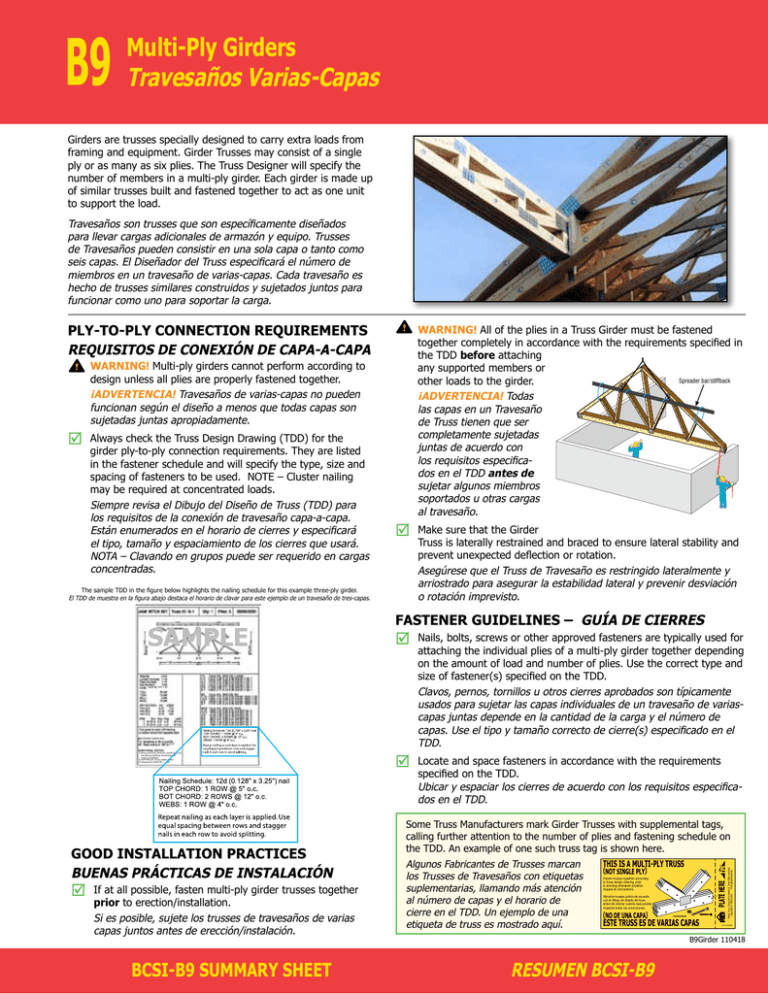
B9 Multi-Ply Girders Travesaños Varias-Capas Girders are trusses specially designed to carry extra loads from framing and equipment. Girder Trusses may consist of a single ply or as many as six plies. The Truss Designer will specify the number of members in a multi-ply girder. Each girder is made up of similar trusses built and fastened together to act as one unit to support the load. Travesaños son trusses que son específicamente diseñados para llevar cargas adicionales de armazón y equipo. Trusses de Travesaños pueden consistir en una sola capa o tanto como seis capas. El Diseñador del Truss especificará el número de miembros en un travesaño de varias-capas. Cada travesaño es hecho de trusses similares construidos y sujetados juntos para funcionar como uno para soportar la carga. PLY-TO-PLY CONNECTION REQUIREMENTS REQUISITOS DE CONExIÓN DE CAPA-A-CAPA Warning! Multi-ply girders cannot perform according to design unless all plies are properly fastened together. ¡Advertencia! Travesaños de varias-capas no pueden funcionan según el diseño a menos que todas capas son sujetadas juntas apropiadamente. Always check the Truss Design Drawing (TDD) for the girder ply-to-ply connection requirements. They are listed in the fastener schedule and will specify the type, size and spacing of fasteners to be used. NOTE – Cluster nailing may be required at concentrated loads. Siempre revisa el Dibujo del Diseño de Truss (TDD) para los requisitos de la conexión de travesaño capa-a-capa. Están enumerados en el horario de cierres y especificará el tipo, tamaño y espaciamiento de los cierres que usará. NOTA – Clavando en grupos puede ser requerido en cargas concentradas. Warning! All of the plies in a Truss Girder must be fastened together completely in accordance with the requirements specified in the TDD before attaching any supported members or Spreader bar/stiffback other loads to the girder. ¡Advertencia! Todas las capas en un Travesaño de Truss tienen que ser completamente sujetadas juntas de acuerdo con los requisitos especificados en el TDD antes de sujetar algunos miembros soportados u otras cargas al travesaño. Make sure that the Girder Truss is laterally restrained and braced to ensure lateral stability and prevent unexpected deflection or rotation. Asegúrese que el Truss de Travesaño es restringido lateralmente y arriostrado para asegurar la estabilidad lateral y prevenir desviación o rotación imprevisto. The sample TDD in the figure below highlights the nailing schedule for this example three-ply girder. El TDD de muestra en la figura abajo destaca el horario de clavar para este ejemplo de un travesaño de tres-capas. 8 SAMPLE FASTENER GUIDELINES – guÍa de cierres Nails, bolts, screws or other approved fasteners are typically used for 2006 IRC/TPI 1-07 RESTRAINT & BRACING CLR 1) Refer to BCSI-B1, BCSI-B2, and BCSI-B3 for handling, installing, restraining and bracing guidlines. 2) All Plates are 20 Ga. unless noted 3) Designed to ANSI/TPI 1 - 2007 attaching the individual plies of a multi-ply girder together depending on the amount of load and number of plies. Use the correct type and size of fastener(s) specified on the TDD. Clavos, pernos, tornillos u otros cierres aprobados son típicamente usados para sujetar las capas individuales de un travesaño de variascapas juntas depende en la cantidad de la carga y el número de capas. Use el tipo y tamaño correcto de cierre(s) especificado en el TDD. Locate and space fasteners in accordance with the requirements specified on the TDD. Ubicar y espaciar los cierres de acuerdo con los requisitos especificados en el TDD. prior to erection/installation. Si es posible, sujete los trusses de travesaños de varias capas juntos antes de erección/instalación. BCSI-B9 SUMMARY SHEET THIS IS A MULTI-PLY TRUSS (NOT SINGLE PLY) Fasten trusses together according to truss design drawing, prior to erecting whenever possible. Inspect all connections. PLATE HERE If at all possible, fasten multi-ply girder trusses together Algunos Fabricantes de Trusses marcan los Trusses de Travesaños con etiquetas suplementarias, llamando más atención al número de capas y el horario de cierre en el TDD. Un ejemplo de una etiqueta de truss es mostrado aquí. Abroche trusses juntos de acuerdo con el dibujo de diseño de truss, antes de erectar cuando sea posible. Inspecte todas las conecciones. (NO DE UNA CAPA) ESTE TRUSS ES DE VARIAS CAPAS Wood Truss Council of America & Truss Plate Institute Copyright © 1992-2004 All Rights Reserved GOOD INSTALLATION PRACTICES buenas prÁcticas de instalaciÓn Some Truss Manufacturers mark Girder Trusses with supplemental tags, calling further attention to the number of plies and fastening schedule on the TDD. An example of one such truss tag is shown here. MPT 20040801 B9Girder 110418 RESUMEN BCSI-B9 MULTI-PLY GIRDERS NAIL FASTENERS – Cierres de Clavos Girder trusses up to three plies can be fastened together with nails. Nail each additional ply in accordance with the specified schedule on the TDD. Trusses de Travesaños hasta tres capas pueden ser sujetados juntos con clavos. Clavar cada capa adicional de acuerdo con el horario especificado en el TDD. Some screw manufacturers require the screws to be installed with the screw heads in the loaded ply, or require a reduction in screw capacity if the screw heads are installed in the unloaded ply. Algunos fabricantes de tornillos requieren que los tornillos son instalados con las cabezas de los tornillos en la capa cargada, o requiere que una reducción en la capacidad del tornillo si las cabezas de los tornillos están instalados en la capa descargada. Two-ply floor trusses are permitted to be Two plies Dos capas Three plies (see Note below). Tres capas (vea la nota abajo). Note: Multi-ply girders that are fastened together with nails at the jobsite shall have the nail heads visible for inspection. This is not required if the multi-ply girder is fastened by the Truss Manufacturer at the manufacturing plant, as the in-plant QC program and thirdparty inspection process assures that the fastening is performed per the requirements of the TDD. Nota: Travesaños de varias-capas que son sujetados juntos con clavos en la obra tendrán las cabezas de los clavos visibles para inspección. Esto no es requerido si el travesaño de varias-capas es sujetado por el Fabricante del Truss en la planta de fabricación, como el programa de QC en-planta y el proceso de inspección del tercero asegurar que el cierre es hecho por los requisitos del TDD. BOLT FASTENERs – Cierres de Perno Install per bolt manufacturer and Truss Designer requirements and specifications. Instale de acuerdo con los requisitos y especificaciones del fabricante del perno y el Diseñador del Truss. Pre-drill all bolt holes. Do not oversize SCREW FASTENERS – Cierres de Tornillos To view a non-printing PDF of this document, visit www.sbcindustry.com/b9. the hole! Use washers at bolt head and nut. Use nails as required. • Girders up to six (6) plies are per- mitted to be connected with bolts. • Maximum five (5) plies for girders supporting loads on one side. D=bolt diameter Girders up to four plies are permitted to be connected with specifically designed high-strength screws. Install per screw manufacturer requirements and Truss Designer specifications. Pre-drilling may be required in structural composite lumber (SCL). See SCL and screw manufacturer’s recommendations. Travesaños D=screw diameter hasta cuatro ≥4D* capas son permitidos a ser conecta- ≥5D* dos con tornillos ≥4D* específicamente *See also screw manufacturer's requirements diseñados para la fuerza alta. Instale de acuerdo con los requisitos del fabricante del tornillo y las especificaciones del Diseñador del Truss. Pre-perforación puede ser requerido en madera compuesto estructural (SCL). Vea las recomendaciones de SCL y del fabricante del tornillo. attached with screws per the TDD and the screw manufacturer’s recommendations. Trusses de dos-capas son permitidos a ser sujetados con tornillos de acuerdo con el TDD y las recomendaciones del fabricante del tornillo. ≥4D ≥5D ≥4D • Maximum six (6) plies for girders supporting loads on both sides. Pre-prefore todos perforaciones de perno. ¡No hacer demasiado grande la perforación! Use arandelas en la cabeza del perno y tuerca. Use clavos como es requerido. • Travesaños hasta seis (6) capas son permitidos a ser conectados con pernos. • Un máximo de cinco (5) capas para travesaños que soportan cargas en un lado. • Un máximo de seis (6) capas para travesaños que soportan cargas en ambos lados. Bolt and screw head locations shall not interfere with fastening of hardware or framing members attached to the girder. Las ubicaciones de las cabezas de pernos y tornillos no impedirán con el sujetando del ferretería o miembros de armazón que sujetarán al travesaño. This document summarizes the information provided in Section B9 of the 2008 Edition of Building Component Safety Information BCSI - Guide to Good Practice for Handling, Installing, Restraining & Bracing of Metal Plate Connected Wood Trusses. Copyright © 2004-2011 Structural Building Components Association and Truss Plate Institute. All Rights Reserved. This guide or any part thereof may not be reproduced in any form without the written permission of the publishers. Printed in the United States of America. Truss Plate Institute 218 North Lee Street, Ste. 312 Alexandria, VA 22314 703/683-1010 • www.tpinst.org 6300 Enterprise Lane • Madison, WI 53719 608/274-4849 • www.sbcindustry.com 2 BCSI-B9 SUMMARY SHEET Disclaimer This copyrighted document is a secure PDF, and while it can be opened, saved and emailed, it cannot be printed. To order copies or receive a complimentary hard copy, contact SBCA at 608/274-4849.
